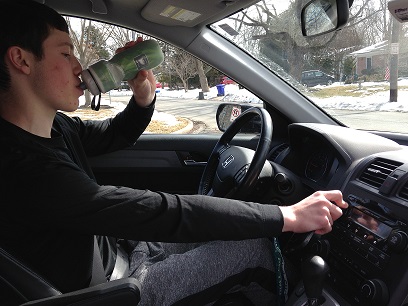Distracted driving: It can wait

Many CHS students have passed the driving test and earned their license but may be tempted by dangerous behind-the-wheel habits.
March 23, 2015
It can wait. Any text, any call, any drink. It can wait. Distractions while driving can be subtle, yet life-threatening: all it takes is half a second to make a mistake.
Whether it’s drunk driving, texting while driving, eating while driving or blasting the stereo, it’s obvious that teens tend to be the most reckless drivers on the roads, and the most vulnerable to distractions.
According to distraction.gov, approximately 421,000 people were injured in motor vehicle crashes involving a distracted driver in 2012, a nine percent increase from the 387,000 people who were injured in 2011.
Junior Collin Schmitz is one student who has been subject to distractions as he drives.
“For me, it’s speeding or getting mad at other drivers,” Schmitz said. “Distracted driving is absolutely unnecessary and anything can wait.”
There are many different types of distractions that can occur on the roads, but only a few specific ways of irresponsible driving stand out.
Racing
Eager teens are the ones who are excited to be out on the streets, but their inexperience while driving makes them want to explore the roads and sometimes try new things behind the wheel. This is why some teens find it exhilarating to try to race another friend.
“When I work patrol, we get quite a few calls to check out drivers squealing wheels, racing through neighborhoods or racing through parking lots quite often,” CHS School Resource Officer Amy Homrock said. “Young people have a feeling of ‘nothing can happen to me, I’m invincible,’ and unfortunately that can have damaging consequences when you think nothing can happen to you.”
New drivers may find this dangerous behavior entertaining, when in fact it can be a real harm to other drivers.
According to senior Ross Allen, students recklessly street race in merging lanes in order to see who will beat the other to the single lane.
Street racing can divert the driver’s attention because rather than paying attention to his or her surroundings, they focus instead on beating their opponent.
Listening to Music and Texting
Another poor habit that student drivers have developed is listening and changing music while driving.
“The worst thing students do while driving is that they listen to loud music and socialize with other friends,” junior Austin Yang said.
Almost every student listens to music while driving, and having to fight over the auxiliary cord can distract drivers from the road.
Junior Ally, who asked that her real name not be used, admits that she has some addictive phone habits while driving.
“When I drive, I use my phone a lot,” Ally said. “Sometimes I’ll even look things up when I’m driving, which is bad.”
With all of today’s new technology, it is understood that students, along with many others, face the temptation of texting while driving. Even though using a hand-held device is illegal while driving, it does not seem to stop people.
“I try not to have bad habits while driving,” Allen said. “I usually ask someone in my car to read texts for me if there is another person. If not, I occasionally check my phone when stopped at a light.”
Driving Under the Influence
The worst thing a driver can do is to drive under the influence. Whether under the influence of alcohol or other illegal substances, drivers can cause at least one person’s life to be in danger as that intoxicated person gets behind the wheel.
“I don’t think driving under the influence is worth the risks, but I see why, when you’re under the influence, you feel the need to drive and want to get home and not make your parents think anything,” Ally said. “We live in a time where we are always on our phones, and our friends are always driving high, and we see other people driving high. We become very comfortable with these things which is wrong because there are so many risks that people don’t realize they are taking.”
Sam, who also asked that his real name not be used, has driven a car while intoxicated. While he knew that he was under the influence, he still decided to drive his car.
“My vision was off when I was driving, and I didn’t realize it,” Sam said. “So whenever I thought that I was in the middle of the road, I actually wasn’t. I remember almost getting into an accident because I lost my focus for a little bit and almost hit the guy coming towards me.”
Sam has also driven high and has been in the car with another high driver.
“When I was in a car with someone else driving high, I felt different,” Sam said. “I had complete trust in them, and when it’s not you driving, you don’t have the responsibility for the other people in the car. I didn’t have my car with me, so when I had to get home, there was no other option except to go in the car with him.”
Distracted driving is and will continue to be a huge issue on the roads. Although police officers try to stop drunk drivers and texting drivers, people will always feel the need to send that short text to a friend, or drive that short distance because they are feeling “okay to drive”.
“The worst thing a young driver can do is to become complacent and feel like they are very familiar with the roads and feel like they don’t need to be as attentive to the roads,” Hamrock said. “But statistically, most accidents happen within a very short distance of where you live, because you are complacent. Because you know that stop light is coming up, you say, ‘Oh no one ever stops there’, and the one time that you make that decision to blow past it, boom, there’s a T-bone accident.”

